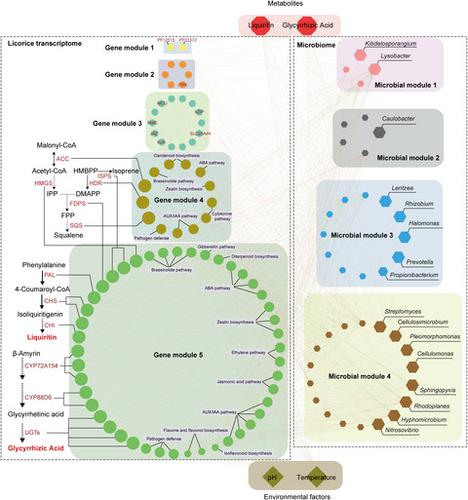当前位置:
X-MOL 学术
›
Plant Biotech. J.
›
论文详情
Our official English website, www.x-mol.net, welcomes your
feedback! (Note: you will need to create a separate account there.)
Multi-omics profiling reveals comprehensive microbe–plant–metabolite regulation patterns for medicinal plant Glycyrrhiza uralensis Fisch
Plant Biotechnology Journal ( IF 10.1 ) Pub Date : 2022-06-06 , DOI: 10.1111/pbi.13868 Chaofang Zhong 1, 2 , Chaoyun Chen 1 , Xi Gao 1 , Chongyang Tan 1 , Hong Bai 1 , Kang Ning 1
Plant Biotechnology Journal ( IF 10.1 ) Pub Date : 2022-06-06 , DOI: 10.1111/pbi.13868 Chaofang Zhong 1, 2 , Chaoyun Chen 1 , Xi Gao 1 , Chongyang Tan 1 , Hong Bai 1 , Kang Ning 1
Affiliation

|
Glycyrrhiza uralensis Fisch is a medicinal plant widely used to treat multiple diseases in Europe and Asia, and its efficacy largely depends on liquiritin and glycyrrhizic acid. The regulatory pattern responsible for the difference in efficacy between wild and cultivated G. uralensis remains largely undetermined. Here, we collected roots and rhizosphere soils from wild (WT) G. uralensis as well as those farmed for 1 year (C1) and 3 years (C3), generated metabolite and transcript data for roots, microbiota data for rhizospheres and conducted comprehensive multi-omics analyses. We updated gene structures for all 40 091 genes in G. uralensis, and based on 52 differentially expressed genes, we charted the route-map of both liquiritin and glycyrrhizic acid biosynthesis, with genes BAS, CYP72A154 and CYP88D6 critical for glycyrrhizic acid biosynthesis being significantly expressed higher in wild G. uralensis than in cultivated G. uralensis. Additionally, multi-omics network analysis identified that Lysobacter was strongly associated with CYP72A154, which was required for glycyrrhizic acid biosynthesis. Finally, we developed a holistic multi-omics regulation model that confirmed the importance of rhizosphere microbial community structure in liquiritin accumulation. This study thoroughly decoded the key regulatory mechanisms of liquiritin and glycyrrhizic acid, and provided new insights into the interactions of the plant's key metabolites with its transcriptome, rhizosphere microbes and environment, which would guide future cultivation of G. uralensis.
中文翻译:

多组学分析揭示了药用植物甘草的综合微生物-植物-代谢物调控模式
Glycyrrhiza uralensis Fisch是一种在欧洲和亚洲广泛用于治疗多种疾病的药用植物,其功效很大程度上取决于甘草素和甘草酸。导致野生和栽培G. uralensis功效差异的监管模式在很大程度上仍未确定。在这里,我们收集了野生 (WT) G. uralensis以及养殖 1 年 (C1) 和 3 年 (C3) 的根和根际土壤,生成了根的代谢物和转录物数据、根际的微生物群数据,并进行了全面的多-组学分析。我们更新了G. uralensis中所有 40 091 个基因的基因结构,并基于 52 个差异表达基因,我们绘制了甘草素和甘草酸生物合成的路线图,其中对甘草酸生物合成至关重要的基因 BAS、CYP72A154 和 CYP88D6 在野生G. uralensis中的表达显着高于栽培G. uralensis . 此外,多组学网络分析发现溶菌与甘草酸生物合成所需的 CYP72A154 密切相关。最后,我们开发了一个整体的多组学调控模型,证实了根际微生物群落结构在甘草素积累中的重要性。该研究深入解读了甘草苷和甘草酸的关键调控机制,为植物关键代谢物与其转录组、根际微生物和环境的相互作用提供了新的见解,为未来甘草的栽培提供指导。
更新日期:2022-06-06
中文翻译:

多组学分析揭示了药用植物甘草的综合微生物-植物-代谢物调控模式
Glycyrrhiza uralensis Fisch是一种在欧洲和亚洲广泛用于治疗多种疾病的药用植物,其功效很大程度上取决于甘草素和甘草酸。导致野生和栽培G. uralensis功效差异的监管模式在很大程度上仍未确定。在这里,我们收集了野生 (WT) G. uralensis以及养殖 1 年 (C1) 和 3 年 (C3) 的根和根际土壤,生成了根的代谢物和转录物数据、根际的微生物群数据,并进行了全面的多-组学分析。我们更新了G. uralensis中所有 40 091 个基因的基因结构,并基于 52 个差异表达基因,我们绘制了甘草素和甘草酸生物合成的路线图,其中对甘草酸生物合成至关重要的基因 BAS、CYP72A154 和 CYP88D6 在野生G. uralensis中的表达显着高于栽培G. uralensis . 此外,多组学网络分析发现溶菌与甘草酸生物合成所需的 CYP72A154 密切相关。最后,我们开发了一个整体的多组学调控模型,证实了根际微生物群落结构在甘草素积累中的重要性。该研究深入解读了甘草苷和甘草酸的关键调控机制,为植物关键代谢物与其转录组、根际微生物和环境的相互作用提供了新的见解,为未来甘草的栽培提供指导。









































 京公网安备 11010802027423号
京公网安备 11010802027423号